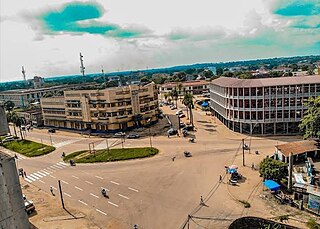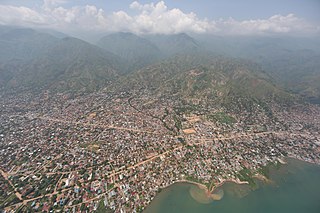
Kinshasa, formerly named Léopoldville until 30 June 1966, is the capital and largest city of the Democratic Republic of the Congo. Once a site of fishing and trading villages along the Congo River, Kinshasa is now one of the world's fastest-growing megacities. Kinshasa's 2024 population was estimated at 17,032,322. It is the most densely populated city in the DRC, the most populous city in Africa, the world's fourth-most-populous capital city, Africa's third-largest metropolitan area, and the leading economic, political, and cultural center of the DRC. Kinshasa houses several industries, including manufacturing, telecommunications, banking, and entertainment. The city also hosts some of DRC's significant institutional buildings, such as the Palais du Peuple, Palais de la Nation, Court of Cassation, Constitutional Court, Cité de l'Union Africaine, Palais de Marbre, Stade des Martyrs, Immeuble du Gouvernement, Kinshasa Financial Center, and multiple federal departments and agencies.

Brazzaville is the capital and largest city of the Republic of the Congo. Administratively, it is a department and a commune. Constituting the financial and administrative centre of the country, it is located on the north side of the Congo River, opposite Kinshasa, the capital city of the Democratic Republic of the Congo.

The Third Republic of the Democratic Republic of the Congo is a unitary state with a five-level hierarchy of types of administrative division. There are nine different types of country subdivision in a new hierarchy with no new types but with two from the previous one abolished.

Kisangani is the capital of Tshopo Province, located on the Congo River in the eastern part of the central Congo Basin in the Democratic Republic of the Congo. It is the country's fifth most populous urban area, with an estimated population of 1,602,144 as of 2018, and the largest of the cities in the tropical woodlands of the Congo.

Karisimbi is a commune of the city of Goma in the North Kivu Province of the eastern region of the Democratic Republic of the Congo. It is named after the nearby Mount Karisimbi.

Goma is the capital and largest city of the North Kivu Province in the eastern region of the Democratic Republic of the Congo. It is located on the northern shore of Lake Kivu and shares borders with Bukumu Chiefdom to the north, Rwanda to the east and Masisi Territory to the west. The city lies in the Albertine Rift, the western branch of the East African Rift, and is only 13–18 km (8.1–11.2 mi) south of the active volcano Mount Nyiragongo. With an approximate area of 75.72 km2 (29.24 sq mi), the city has an estimated population of nearly 2 million people according to the 2022 census.

The Stade des Martyrs de la Pentecôte, or commonly referred to as the Stade des Martyrs, is the national stadium of the Democratic Republic of the Congo, located in the Kinshasa commune of the capital Kinshasa. With a seating capacity of 80,000, it is the largest stadium in the Democratic Republic of the Congo and the fourth-largest stadium in Africa. It serves as the home stadium for the Congolese football national team, Association Sportive Vita Club, and Daring Club Motema Pembe, making it the largest multifunctional venue in the country.

Uvira is a city strategically located in the South Kivu Province of the eastern region of the Democratic Republic of the Congo. Covering approximately 16 square kilometers and with an estimated population of 726,000 as of 2024, it borders Bafuliru Chiefdom and Ruzizi Plain Chiefdom to the north, Bavira Chiefdom to the south, and Lake Tanganyika and the Ruzizi River to the east. These rivers form natural boundaries between the DRC and Burundi. Located in the Ruzizi Plain at a low altitude, the city lies between Burundi's Congo-Nile ridge and the Mitumba mountains.

Mont Ngafula, or Mont-Ngafula, is a commune in the Lukunga District of Kinshasa, in the western part of the Democratic Republic of the Congo. By its surface area, Mont Ngafula is the third-largest commune in Kinshasa's city-province. It is located in the hilly southern area of Kinshasa and is intersected by the Lukaya River valley in its southern portion. The boundary with the Ngaliema commune is defined by the Lukunga River. Mont Ngafula shares borders with the Makala commune to the north, the Kongo Central Province to the south, the Lemba and Kisenso communes to the east, and the Selembao commune to the west. It has an estimated population of 718,197 (2015).

Masina is a municipality (commune) in the Tshangu District of Kinshasa, the capital city of the Democratic Republic of the Congo.

Gombe, also known as La Gombe, or Downtown Kinshasa, is one of the 24 communes of Kinshasa, in the western part of the Democratic Republic of the Congo. Encompassing a vast area of approximately 29.33 square kilometers, it is home to an approximate population of 49,024 residents (2014).

The Boulevard du 30 Juin is a major 5‑km street in Kinshasa, Democratic Republic of the Congo (DRC). It is the city center's main transport artery, connecting the southern area of La Gombe with Kintambo and the Ngaliema to the west.

Maluku is one of the 24 communes that are the administrative divisions of Kinshasa, the capital city of the Democratic Republic of the Congo. This eastern rural commune accounts for 79% of the land area of the city-province,

Tshangu is an area of the capital city of Kinshasa, Democratic Republic of the Congo, comprising five of the city-province's twenty-four administrative divisions—the communes of Kimbanseke, Maluku, Masina, Ndjili and Nsele. It is one of the four so-called districts of Kinshasa. These were the administrative divisions of Kinshasa during much of the Mobutu years (1965-1997) and around which a number of government systems and services are still organized. For instance, Tshangu makes up an eighteen-member National Assembly constituency designated as Kinshasa IV. However, these districts are not part of Congo's territorial organization.

Lukunga is an area of the capital city of Kinshasa, Democratic Republic of the Congo, comprising seven of the city-province's twenty-four administrative divisions—the communes of Barumbu, Gombe, Kinshasa, Kintambo, Lingwala, Mont Ngafula and Ngaliema. It is one of the four so-called districts of Kinshasa. These were the administrative divisions of Kinshasa during much of the Mobutu years (1965-1997) and around which a number of government systems and services are still organized. For instance, Lukunga makes up a fourteen-member National Assembly constituency designated as Kinshasa I. However, these districts are not part of Congo's territorial organization.
MadimbaTerritory is a territory in the Kongo Central Province of the Democratic Republic of the Congo (DRC). Its seat is the town of Madimba. The region covers an area of 8,260 square miles and is situated 100 km from Kinshasa. It spans from the Lukusu River in the north to Kintano in the west, and from the Inkisi River in the west to Kinkosi-Luidi in the southeast. The territory borders Kasangulu Territory to the northeast, Kimvula Territory to the southeast, Mbanza-Ngungu Territory to the west, and Angola to the south. Madimba Territory is home to an approximate population of 463,132 residents.

Goma is a commune of the city of Goma in the North Kivu Province of the eastern region of the Democratic Republic of the Congo. It encompasses the southernmost sector of the city, extending from the principal main road towards the shores of Lake Kivu. As per a 2018 estimate, the commune had approximately 333,727 residents.
The cities of the Democratic Republic of the Congo are administrative divisions of provinces with the exception of Kinshasa which itself has the status of a province. Cities are further divided into communes. They are led by mayors except for Kinshasa which is led by a governor.

Nsele Valley Park, colloquially known as Kingakati Park or N'Sele Nature Reserve, is a nature reserve located in the Maluku commune of Kinshasa in the western region of the Democratic Republic of the Congo (DRC). It is bordered to the north by the National N1, to the east by the Batéké Plateau, to the south by the Kindu group, the Nsingi mountains, and to the west by the Mangweme, Kindobo and Bambala villages. The park was established by then-President Joseph Kabila and his wife Olive Lembe di Sita and operates as a subsidiary of Ferme Espoir, an agro-food farm spanning Haut Katanga, Kongo Central, Kinshasa, and North Kivu.

The Kinshasa Central Market, colloquially referred to as Zando in Lingala, is a marketplace located in Kinshasa's Gombe commune, in the Democratic Republic of the Congo. Covering an expansive 90,000 square meters, it was Kinshasa's largest marketplace during Mobutu Sese Seko's reign. It was eventually eclipsed by the Marché de la Liberté during the late president Laurent-Désiré Kabila's administration. As of May 1989, the market accommodated 15,500 vendors. By 2020, that number had risen to 35,000 vendors. Renowned for its wide assortment of products, including fruits, vegetables, meat, fish, spices, cooked meals such as chikwangue, clothing, fabrics, shoes, accessories, and household goods, the marketplace also showcases distinctive Congolese handicrafts and souvenirs for tourists and visitors.


















